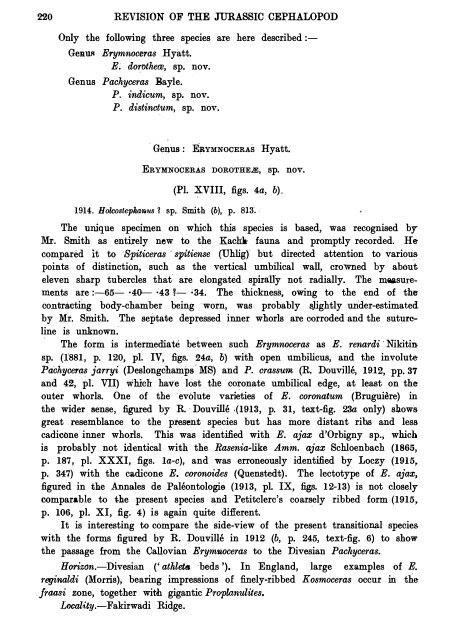ialontolngia ndita,
ialontolngia ndita,
ialontolngia ndita,
Create successful ePaper yourself
Turn your PDF publications into a flip-book with our unique Google optimized e-Paper software.
220<br />
REVISION OF THE JURASSIC CEPHALOPOD<br />
Only the following three species are here described :<br />
GeRm Erymnoceras Hyatt.<br />
E dorothere, sp. nov.<br />
Genus Pachyceras :Bayle.<br />
P. indicum, sp. nov.<br />
P. distinctum, sp. nov .<br />
. Ge:flUS : EYMNOCERA.S Hyatt.<br />
ERYMNOCERAS DOROTHElE, sp. nov.<br />
(PI. VIII, figs. 4a, b).<br />
1914. Holcostephau,us 1 sp. Smith (b), p. 813' . .<br />
The unique specimen on which this species is based, was recognised by<br />
Mr. Smith as entirely new to the Kachlt fauna and promptly recorded. He<br />
compared it to Spiticeras · spitiense (Uhlig) but directed attention to various<br />
points of distinction, such as the vertical umbilical wall, croWn.ed by about<br />
eleven sharp tubercles that· are elongated spirally not radially.<br />
The mu.surements<br />
are :-65- ·40-- 43 1- ;34. The thickness, oWing to the end of the<br />
contracting body-chamber being worn, was probably &lightly under-estimated<br />
by Mr. Smith.<br />
The septate depressed inner whorls are oorroded and the sutureline<br />
is unknown<br />
The form is intermediate between such Erymnoceras as E. renardi Nikitin<br />
sp. (1'881, p. 120, pl. IV, figs. 24a, b) with open umbilicus, and the involute<br />
Pachyceras jarryi (Deslongchamps ' MS) and P. crassum (R. Douvme, 1912, pp. 37<br />
and 4!, pl. VII) which have lost the coronate umbilical edge, at least on the<br />
outer whorls. One of the ·evolute varieties of E. coronatum (Bruguiere) in<br />
the wider sense, figured by R. · Douville ·(1913, p. 31, text-fig. 23a only) shows<br />
great resemblance to the present species but has more distant ribs and less<br />
cadicone inner whorls.<br />
This was identified with E. ajax d'Orbigny sp., which<br />
is probably not identical with the Rasenia-like Amm. ajax Schloenbach (1865,<br />
p. 187, pl. XXXI, figs. la-c), and was erroneously identified by Loczy (1915<br />
p. 347) with the cadicone E. coronoides (Quenstedt). The lectotype of E. ajax,<br />
figured in the Annales de Paleontologie (1913, pl. IX, figs. 12-13) is not closely<br />
comparable to the present species and Petitclerc's coarsely ribbed form (1915,.<br />
p. 106, pl. XI, :fig. 4) is again quite different.<br />
It is interesting to compare the side-view of the present transitional species<br />
with the forms figured by R . . Douville in 1912 (b, p. 245, text-fig . . 6) to show<br />
the passage from the Callovian Erym'aoceras to the Divesian Pachyceras.<br />
Horizon.-Divesian ( ' athlet& beds '). In England, large examples of E.<br />
reyinaldi (Morris), bearing impressions of finely-ribbed Kosmoceras occur in<br />
fraasi zone, together with gigantic Proplanulites.<br />
Locality.-Fakirwadi Ridge.<br />
·<br />
the
















